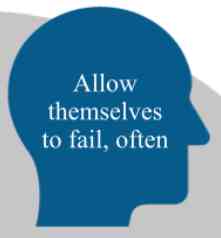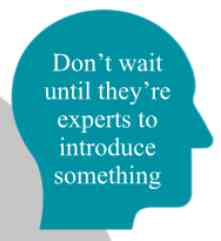Viewing teaching as a collaborative process also helps break down the traditional hierarchies that can inhibit student engagement and participation. When teachers acknowledge that they too are learning, they validate the experiences and insights that students bring to the classroom. This mutual exchange of ideas can lead to deeper understanding and innovation, as diverse perspectives are considered and integrated. Palmer (1998) emphasizes the importance of teachers being present and authentic in their interactions with students, arguing that this authenticity fosters a genuine community of learners. By embracing their role as co-learners, teachers not only enhance their own professional development but also empower students to take ownership of their learning, thereby creating a more inclusive and empowering educational environment.
3. Allow themselves to fail, often

James 1:2-4 - "Consider it pure joy, my brothers and sisters, whenever you face trials of many kinds, because you know that the testing of your faith produces perseverance. Let perseverance finish its work so that you may be mature and complete, not lacking anything."
Modern teachers who allow themselves to fail, often embrace failure as an integral part of the learning and growth process. This acceptance of failure serves as a powerful model for students, demonstrating that setbacks are not only inevitable but also valuable opportunities for development. By transparently sharing their own experiences of failure and how they overcame them, teachers can normalize the concept of failure, reducing the stigma and fear associated with it. This approach aligns with Dweck’s (2006) research on growth mindset, which emphasizes that viewing challenges and failures as opportunities to learn fosters resilience and persistence. When teachers openly navigate their own failures, they illustrate the process of problem-solving, reflection, and perseverance, providing students with a realistic and constructive framework for dealing with their own challenges.
Furthermore, by allowing themselves to fail, teachers create a classroom culture that encourages risk-taking and innovation. In such an environment, students feel more comfortable experimenting with new ideas and approaches without the paralyzing fear of making mistakes. This kind of supportive atmosphere is crucial for fostering creativity and critical thinking, skills that are essential for success in the 21st century. Research by Boaler (2016) highlights that students who are encouraged to struggle and fail in a supportive environment tend to develop deeper understanding and greater confidence in their abilities. When failure is seen as a natural and valuable part of the learning process, students are more likely to engage fully, take academic risks, and ultimately achieve higher levels of mastery and innovation. By modeling this mindset, teachers not only enhance their own teaching practices but also equip their students with essential life skills for continuous learning and adaptation.
4. Don't wait until they're experts to introduce something

Ecclesiastes 11:4 - "Whoever watches the wind will not plant; whoever looks at the clouds will not reap."
Modern educators understand the importance of being proactive and adventurous in their teaching methods, which includes introducing new ideas and technologies before mastering them completely. By doing so, they demonstrate a willingness to learn alongside their students, which fosters a collaborative and inclusive learning environment. This approach not only keeps the classroom dynamic and up-to-date with the latest advancements but also models a continuous learning mindset for students. It encourages a culture where both teachers and students are co-explorers, discovering and navigating new tools and concepts together. As Richardson (2015) suggests, embracing new technologies and methodologies without waiting for complete expertise encourages a more innovative and adaptive educational practice.
This approach also helps demystify the learning process, showing students that expertise is not a prerequisite for engagement. When teachers dive into new subjects or technologies with their students, they highlight the importance of curiosity and the learning journey itself over the end result. This can be particularly empowering for students, who might otherwise feel intimidated by new and complex topics. According to Mishra and Koehler (2006), teachers who integrate technology effectively are those who understand the interplay between technology, pedagogy, and content knowledge. By introducing new ideas and technologies as co-learners, teachers not only expand their own pedagogical toolkit but also prepare students to be flexible and resilient learners, capable of adapting to the ever-evolving landscape of knowledge and technology.
5. Move into their students' world, even if it's foreign territory

1 Corinthians 9:22 - "To the weak I became weak, to win the weak. I have become all things to all people so that by all possible means I might save some."























